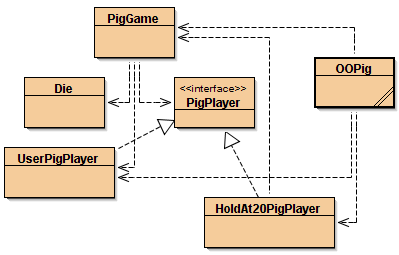

Pig is a folk jeopardy dice game with simple rules: Two players race to reach 100 points. Each turn, a player repeatedly rolls a die until either a 1 ("pig") is rolled or the player holds and scores the sum of the rolls (i.e. the turn total). At any time during a player's turn, the player is faced with two decisions:
Problem: Create an object-oriented implementation of a game of Pig where the user plays against a "hold at 20 or goal" computer player that rolls until a 1 ("pig") is rolled, or the turn total is greater than or equal to 20, or the score plus the turn total is greater than or equal to 100. The first player is chosen randomly.
O-O Design Constraints:
BlueJ UML diagram:

Although one need not implement in Java, the object-oriented specification is supplied via HTML Javadoc documentation. The global input/output specification is given here:
Input Format: An empty input (i.e., Enter) indicates that the user wishes to roll. Any entered line of non-zero length indicates that the user wishes to hold.
Output Format:
Sample Transcript (input underlined):
You will be player 2. Enter nothing to roll; enter anything to hold. Player 1 score: 0 Player 2 score: 0 It is player 1's turn. Roll: 5 Roll: 3 Roll: 5 Roll: 1 Turn total: 0 New score: 0 Player 1 score: 0 Player 2 score: 0 It is player 2's turn. Roll: 6 Turn total: 6 Roll/Hold? (Enter) Roll: 5 Turn total: 11 Roll/Hold? (Enter) Roll: 6 Turn total: 17 Roll/Hold? (Enter) Roll: 2 Turn total: 19 Roll/Hold? (Enter) Roll: 2 Turn total: 21 Roll/Hold? h Turn total: 21 New score: 21 Player 1 score: 0 Player 2 score: 21 It is player 1's turn. Roll: 5 Roll: 6 Roll: 3 Roll: 5 Roll: 1 Turn total: 0 New score: 0 Player 1 score: 0 Player 2 score: 21 It is player 2's turn. Roll: 6 Turn total: 6 Roll/Hold? (Enter) Roll: 6 Turn total: 12 Roll/Hold? (Enter) Roll: 2 Turn total: 14 Roll/Hold? (Enter) Roll: 6 Turn total: 20 Roll/Hold? h Turn total: 20 New score: 41 Player 1 score: 0 Player 2 score: 41 It is player 1's turn. Roll: 3 Roll: 3 Roll: 6 Roll: 4 Roll: 4 Turn total: 20 New score: 20 Player 1 score: 20 Player 2 score: 41 It is player 2's turn. Roll: 3 Turn total: 3 Roll/Hold? (Enter) Roll: 3 Turn total: 6 Roll/Hold? (Enter) Roll: 2 Turn total: 8 Roll/Hold? (Enter) Roll: 2 Turn total: 10 Roll/Hold? (Enter) Roll: 4 Turn total: 14 Roll/Hold? (Enter) Roll: 2 Turn total: 16 Roll/Hold? (Enter) Roll: 4 Turn total: 20 Roll/Hold? h Turn total: 20 New score: 61 Player 1 score: 20 Player 2 score: 61 It is player 1's turn. Roll: 5 Roll: 1 Turn total: 0 New score: 20 Player 1 score: 20 Player 2 score: 61 It is player 2's turn. Roll: 3 Turn total: 3 Roll/Hold? (Enter) Roll: 3 Turn total: 6 Roll/Hold? (Enter) Roll: 5 Turn total: 11 Roll/Hold? (Enter) Roll: 2 Turn total: 13 Roll/Hold? (Enter) Roll: 6 Turn total: 19 Roll/Hold? h Turn total: 19 New score: 80 Player 1 score: 20 Player 2 score: 80 It is player 1's turn. Roll: 3 Roll: 1 Turn total: 0 New score: 20 Player 1 score: 20 Player 2 score: 80 It is player 2's turn. Roll: 2 Turn total: 2 Roll/Hold? (Enter) Roll: 2 Turn total: 4 Roll/Hold? (Enter) Roll: 4 Turn total: 8 Roll/Hold? (Enter) Roll: 2 Turn total: 10 Roll/Hold? (Enter) Roll: 3 Turn total: 13 Roll/Hold? (Enter) Roll: 6 Turn total: 19 Roll/Hold? (Enter) Roll: 5 Turn total: 24 Roll/Hold? h Turn total: 24 New score: 104
Extra Exercises:
1. Use an alternative computer play policy. Let i be the player's score, j be the opponent's score, and k be the current turn total. Some alternative play policies:
2. Allow play of multiple games, alternating the starting player and computing win statistics.